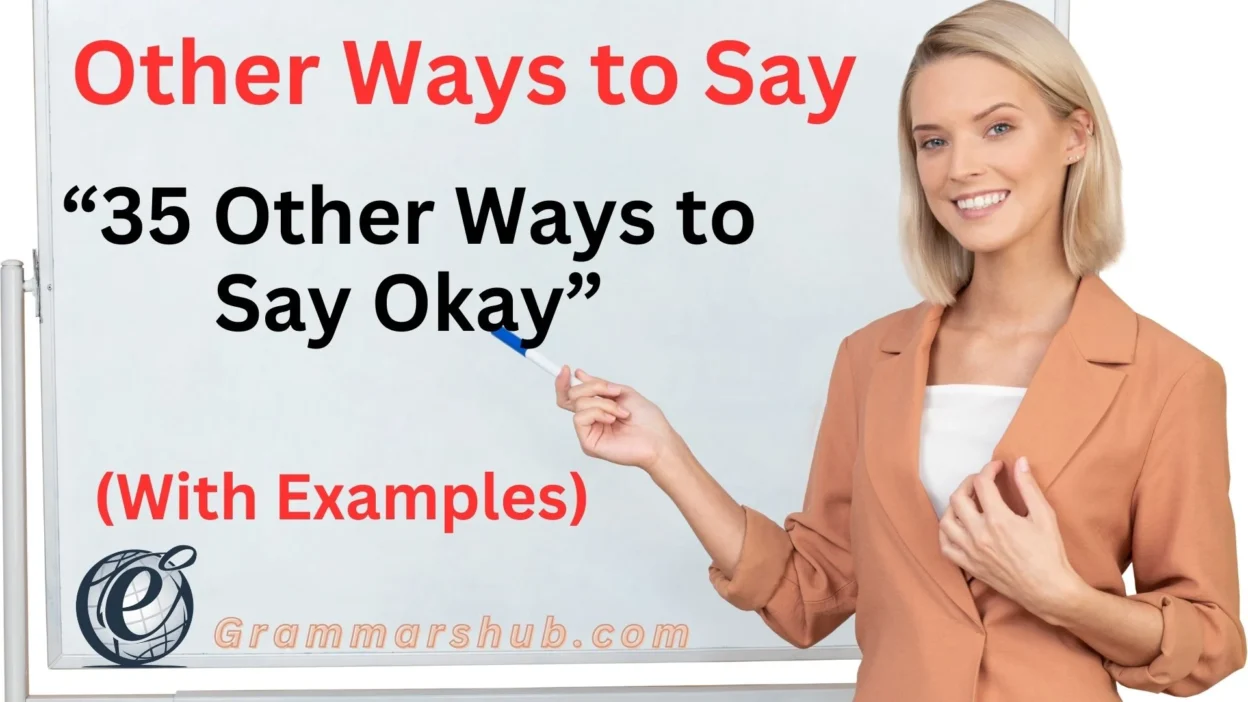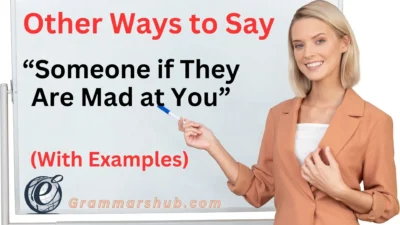In communication, finding the right words can transform a simple exchange into a meaningful connection. Saying “Okay” may feel simple, but it can often come off as impersonal, or even indifferent. For those looking to express themselves with warmth, care, and thoughtful phrasing, it’s helpful to have a variety of alternatives at hand.
These alternatives can convey more than just agreement—they can show empathy, understanding, and genuine consideration. In this article, we’ll explore 35 different ways to say “Okay”, offering you tools to enhance your communication and create more meaningful interactions.
What Does “Okay” Mean?
“Okay” is a common expression used to indicate agreement, acknowledgment, or readiness. It’s typically short, neutral, and easy to use in conversations, but at times, it can come off as a little too brief or impersonal. Using alternatives gives you a chance to express your sentiments more thoughtfully, allowing you to create deeper connections.
Is It Professional/Polite to Say “Okay”?
While “Okay” is widely understood and commonly used in both casual and professional settings, it can sometimes feel too curt in more formal conversations. In a professional setting, depending on the context, using alternatives can help convey politeness, enthusiasm, or agreement in a way that feels more respectful and engaged. It’s essential to gauge the tone of your conversation and the relationship you have with the person you’re speaking with before deciding whether to use “Okay” or a more thoughtful alternative.
Advantages and Disadvantages of Using “Okay”
Advantages:
- Quick and easy: It’s a simple word that anyone can understand.
- Neutral tone: It’s rarely offensive, making it safe to use in many situations.
Disadvantages:
- Can feel impersonal: It may come across as disengaged or indifferent.
- Lacks warmth: It doesn’t always convey enthusiasm or understanding, which can be important in deeper conversations.
Now, let’s dive into some alternative ways to say “Okay”, and explore how you can use them to make your communication more meaningful!
1. Sure
Meaning: A positive affirmation, similar to “Okay,” but with a slightly more enthusiastic or willing tone.
Detailed Explanation: “Sure” shows a willingness to comply or agree with something. It’s often seen as an enthusiastic agreement.
Scenario Example:
- Person A: “Can you help me with this task?”
- Person B: “Sure, I’d be happy to!”
Best Use: Use when you’re willing to do something or agree with a suggestion, especially in informal settings.
Tone: Friendly and agreeable.
2. Absolutely
Meaning: A strong affirmation, often used to express complete agreement or eagerness.
Detailed Explanation: This word is often used to show wholehearted agreement and enthusiasm.
Scenario Example:
- Person A: “Do you want to join us for dinner tonight?”
- Person B: “Absolutely! I’d love to.”
Best Use: Best used when you’re very excited or fully on board with something.
Tone: Enthusiastic and supportive.
3. Of Course
Meaning: A friendly and polite way of saying “Yes” or “Okay,” often used when something is a given.
Detailed Explanation: “Of course” is a reassuring and warm response that conveys a sense of certainty or obviousness.
Scenario Example:
- Person A: “Could you send me that report by the end of the day?”
- Person B: “Of course, I’ll have it ready for you.”
Best Use: Use in both professional and personal settings when you want to reassure the other person that you’re happy to help.
Tone: Polite and reassuring.
4. No Problem
Meaning: A casual way to express that something is not difficult or inconvenient.
Detailed Explanation: “No problem” implies that fulfilling a request will not be a hassle for you.
Scenario Example:
- Person A: “Can you pass me the salt?”
- Person B: “No problem!”
Best Use: Suitable for informal situations when you want to convey ease and helpfulness.
Tone: Casual and relaxed.
5. Got It
Meaning: A way of showing that you understand or will take care of something.
Detailed Explanation: This phrase suggests that you’ve understood the task or request and will proceed accordingly.
Scenario Example:
- Person A: “Please send the email by 3 PM.”
- Person B: “Got it, I’ll handle it.”
Best Use: Best for situations where clarity is key, especially when you need to confirm instructions or tasks.
Tone: Clear and confident.
6. Fine
Meaning: A simple affirmation that something is acceptable or agreeable.
Detailed Explanation: While similar to “Okay,” “fine” often carries a more neutral or mildly agreeable tone. It can indicate that you’re okay with the situation, but not overly excited about it.
Scenario Example:
- Person A: “We can meet at 6 PM instead of 5?”
- Person B: “Fine, that works for me.”
Best Use: Use when you agree, but want to maintain a neutral stance.
Tone: Neutral or slightly indifferent.
7. Sounds Good
Meaning: An informal and friendly way of agreeing with a suggestion.
Detailed Explanation: This phrase is used to express that you’re happy with a suggestion or plan.
Scenario Example:
- Person A: “How about we grab lunch at 1 PM?”
- Person B: “Sounds good to me!”
Best Use: Perfect for informal conversations, especially when plans are being made.
Tone: Positive and casual.
8. Alright
Meaning: A way to express agreement or acceptance of a situation, often used in informal contexts.
Detailed Explanation: “Alright” is similar to “Okay,” but can also indicate that you are moving forward with something.
Scenario Example:
- Person A: “Let’s go ahead and do it then.”
- Person B: “Alright, I’m on board.”
Best Use: Casual and informal, ideal for when you’re agreeing to something after some discussion.
Tone: Easy-going and affirming.
9. Okay, Great
Meaning: An enthusiastic form of saying “Okay,” conveying excitement or satisfaction with something.
Detailed Explanation: The addition of “Great” gives the expression more energy and enthusiasm.
Scenario Example:
- Person A: “I’ll take care of that for you.”
- Person B: “Okay, great! Thanks!”
Best Use: Perfect for situations where you’re both agreeing and expressing enthusiasm or appreciation.
Tone: Positive and upbeat.
10. Sure Thing
Meaning: A casual and friendly affirmation.
Detailed Explanation: “Sure thing” is used when you want to confirm that something will be done or that you’re in agreement.
Scenario Example:
- Person A: “Could you send me the report by noon?”
- Person B: “Sure thing, I’ll get it to you.”
Best Use: Informal and conversational, ideal for friends, family, or coworkers.
Tone: Friendly and confident
11. Sounds Like a Plan
Meaning: A fun and engaging way of agreeing to a suggestion.
Detailed Explanation: This phrase implies that you’re in agreement and ready to move forward with the idea presented.
Scenario Example:
- Person A: “Let’s meet at 7 PM.”
- Person B: “Sounds like a plan!”
Best Use: Great for casual, friendly situations when you’re making plans.
Tone: Positive and engaging.
12. I’m On It
Meaning: A confident, assertive way of confirming that you’ll take action on a request.
Detailed Explanation: When you say “I’m on it,” you’re expressing your commitment to completing a task or responsibility.
Scenario Example:
- Person A: “Can you handle the presentation slides for tomorrow?”
- Person B: “I’m on it!”
Best Use: Suitable for professional and personal scenarios where you want to show your proactive attitude.
Tone: Confident and committed.
13. I’m Good with That
Meaning: An informal, easy-going way of saying you agree or are comfortable with something.
Detailed Explanation: “I’m good with that” conveys agreement while also sounding relaxed and open.
Scenario Example:
- Person A: “How about we meet at the café on Main Street?”
- Person B: “I’m good with that.”
Best Use: Casual and laid-back, perfect for friendly situations.
Tone: Relaxed and agreeable.
14. No Worries
Meaning: A relaxed, reassuring way of saying there’s no problem with a request or suggestion.
Detailed Explanation: This phrase emphasizes that something is not a burden and conveys a sense of calm.
Scenario Example:
- Person A: “Sorry to bother you with this.
- Person B: “No worries, I’m happy to help!
Best Use: Ideal for situations where you want to reassure someone that everything is fine and there’s no inconvenience.
Tone: Reassuring and relaxed.
15. Consider It Done
Meaning: A confident way of expressing that you’ve agreed to do something and will take care of it.
Detailed Explanation: “Consider it done” shows strong commitment and certainty that the task will be completed.
Scenario Example:
- Person A: “Can you help me with the project tomorrow?”
- Person B: “Consider it done!”
Best Use: Best for situations where you want to communicate both agreement and reliability.
Tone: Confident and committed.
16. Makes Sense
Meaning: A way to agree while also acknowledging that the statement or suggestion is logical.
Detailed Explanation: When you say “Makes sense,” you’re confirming understanding while also indicating that you see the reasoning behind something.
Scenario Example:
- Person A: “Let’s take a break and come back to this later.”
- Person B: “Makes sense. We’ll have a fresh perspective.”
Best Use: When you want to agree with logic and reasoning, especially in discussions or decision-making.
Tone: Thoughtful and understanding.
17. Fair Enough
Meaning: A way to acknowledge that something is reasonable or acceptable.
Detailed Explanation: This phrase is often used when you’re coming to terms with someone else’s point of view, even if you initially had doubts.
Scenario Example:
- Person A: “I think we should go with the first design. It fits our budget.”
- Person B: “Fair enough. Let’s proceed with that.”
Best Use: When you want to acknowledge the validity of an idea, even if you weren’t initially convinced.
Tone: Open-minded and accepting.
18. Alright Then
Meaning: A casual way to express agreement or readiness to move forward.
Detailed Explanation: This phrase signals that you’re okay with what has been decided and are ready to proceed.
Scenario Example:
- Person A: “Shall we head out now?”
- Person B: “Alright then, let’s go!”
Best Use: Great for informal situations when you’re confirming readiness or agreement.
Tone: Neutral and accepting.
19. That Works
Meaning: A simple way of agreeing that something is acceptable.
Detailed Explanation: “That works” is often used when someone suggests a plan, and you’re fine with it.
Scenario Example:
- Person A: “Can we meet at 3 PM instead?”
- Person B: “That works for me.”
Best Use: When confirming that a plan or decision is acceptable to you.
Tone: Easygoing and cooperative.
20. I’m Fine with That
Meaning: A way to express that you have no objections.
Detailed Explanation: This phrase conveys that you don’t have a strong opinion either way but are okay with the decision.
Scenario Example:
- Person A: “Do you mind if we take a later flight?”
- Person B: “I’m fine with that.”
Best Use: When you want to confirm agreement in a neutral, flexible manner.
Tone: Neutral and accommodating.
21. That’s Okay
Meaning: A reassuring way to confirm acceptance.
Detailed Explanation: This phrase is often used to ease a situation or let someone know their request or action is acceptable.
Scenario Example:
- Person A: “Sorry, I forgot to call earlier.”
- Person B: “That’s okay, I understand!”
Best Use: Best for comforting someone or showing patience.
Tone: Reassuring and kind.
22. You Got It
Meaning: A confident and supportive way of agreeing to do something.
Detailed Explanation: “You got it” conveys enthusiasm and a willingness to complete a request.
Scenario Example:
- Person A: “Could you send me that file?”
- Person B: “You got it! I’ll send it right now.”
Best Use: Great for professional and friendly situations where you want to express confidence.
Tone: Positive and enthusiastic.
23. Will Do
Meaning: A short and polite way to confirm that you’ll take care of something.
Detailed Explanation: This phrase is often used when acknowledging a task or request in a professional setting.
Scenario Example:
- Person A: “Please send the report by 5 PM.”
- Person B: “Will do!”
Best Use: Perfect for work-related tasks or quick confirmations.
Tone: Professional and efficient.
24. Roger That
Meaning: A playful but clear way to acknowledge instructions.
Detailed Explanation: This phrase originated from radio communication and means “I understand and acknowledge.”
Scenario Example:
- Person A: “Make sure to lock the door before you leave.”
- Person B: “Roger that!”
Best Use: Good for informal, lighthearted interactions where you want to add a bit of fun.
Tone: Playful and clear.
25. Noted
Meaning: A concise way to acknowledge information.
Detailed Explanation: This word is often used in professional settings to indicate that you’ve received and understood information.
Scenario Example:
- Person A: “The deadline has been moved to Friday.”
- Person B: “Noted. I’ll adjust my schedule.”
Best Use: Best for professional and academic settings where brief acknowledgment is preferred.
Tone: Professional and efficient.
26. I Hear You
Meaning: A way to show that you understand someone’s perspective.
Detailed Explanation: This phrase emphasizes active listening and empathy rather than just agreement.
Scenario Example:
- Person A: “I feel really stressed about this project.”
- Person B: “I hear you. Let’s figure out a way to make it easier.”
Best Use: Ideal for emotionally supportive conversations.
Tone: Empathetic and understanding.
27. I Get It
Meaning: A simple way to show understanding.
Detailed Explanation: “I get it” reassures the other person that you understand their perspective or situation.
Scenario Example:
- Person A: “I need some time to think about this.”
- Person B: “I get it, take your time.”
Best Use: When offering understanding and support.
Tone: Warm and reassuring.
28. Works for Me
Meaning: A casual way of agreeing to a plan or decision.
Detailed Explanation: This phrase shows that you’re fine with what’s being proposed.
Scenario Example:
- Person A: “Shall we start at 10 AM instead?”
- Person B: “Works for me!”
Best Use: Best for casual and friendly conversations.
Tone: Laid-back and agreeable.
29. Cool
Meaning: A relaxed and informal way of saying “Okay.”
Detailed Explanation: “Cool” conveys approval or acknowledgment in a laid-back way.
Scenario Example:
- Person A: “I’ll see you at 5 PM.”
- Person B: “Cool, see you then!”
Best Use: Best for casual interactions among friends or colleagues.
Tone: Relaxed and informal.
30. Agreed
Meaning: A formal yet simple way of confirming agreement.
Detailed Explanation: “Agreed” is a clear and professional way of expressing that you’re on the same page.
Scenario Example:
- Person A: “I think we should go with Option B.”
- Person B: “Agreed. That makes the most sense.”
Best Use: Suitable for professional settings, meetings, and negotiations.
Tone: Professional and decisive.
31. Fine by Me
Meaning: A relaxed way of expressing that you have no objections.
Detailed Explanation: This phrase is a little more casual than “Fine” but still neutral. It shows that while you may not have a strong opinion, you’re okay with what’s being decided.
Scenario Example:
- Person A: “Let’s go with the second option.”
- Person B: “Fine by me.”
Best Use: Perfect for when you don’t have a preference but are happy to go along with the decision.
Tone: Casual and easygoing.
32. That’s Fine
Meaning: A simple way to indicate acceptance.
Detailed Explanation: “That’s fine” is slightly more neutral than “Okay” and can sometimes carry a subtle undertone, depending on context.
Scenario Example:
- Person A: “Would you mind if we reschedule?”
- Person B: “That’s fine.”
Best Use: Use when agreeing to something without strong enthusiasm but still being polite.
Tone: Neutral or slightly indifferent.
33. Very Well
Meaning: A formal way of saying “Okay” or agreeing to something.
Detailed Explanation: “Very well” carries an air of professionalism or politeness, making it a great choice for formal interactions.
Scenario Example:
- Person A: “Shall we proceed with the meeting?”
- Person B: “Very well, let’s begin.”
Best Use: Best for professional and formal conversations where you want to sound polished.
Tone: Formal and refined.
34. Go Ahead
Meaning: A phrase that gives permission or approval for someone to proceed.
Detailed Explanation: This phrase is often used when someone is waiting for your approval to do something, and you’re granting it.
Scenario Example:
- Person A: “Can I send the email now?”
- Person B: “Go ahead.”
Best Use: Best for situations where you want to give permission or approval for action.
Tone: Encouraging and approving.
35. All Good
Meaning: A reassuring way to say everything is fine or that you agree.
Detailed Explanation: “All good” conveys a relaxed, easygoing tone, letting someone know that there’s no issue or that you’re comfortable with the situation.
Scenario Example:
- Person A: “Sorry for the delay!”
- Person B: “No worries, all good!”
Best Use: Perfect for casual and friendly interactions when you want to reassure someone or confirm that you’re okay with something.
Tone: Relaxed and reassuring.
Conclusion
Using alternatives to “Okay” can add warmth, clarity, and nuance to your conversations. Whether you’re looking to sound more professional, empathetic, or enthusiastic, choosing the right phrase can make all the difference. Next time you’re about to say “Okay,” try one of these expressions instead to create a more meaningful interaction!




